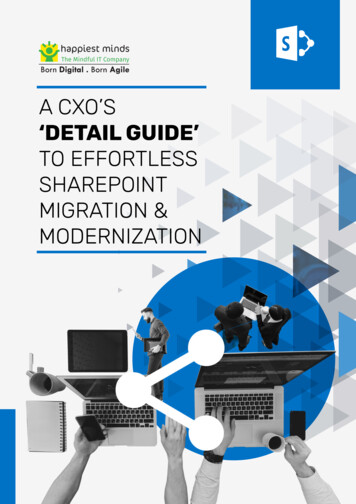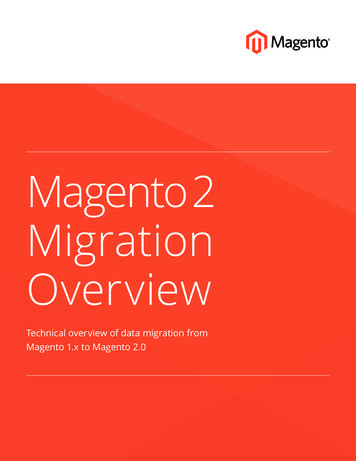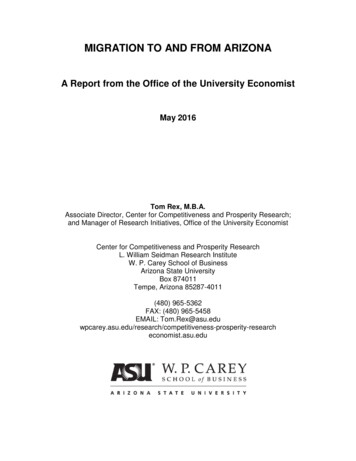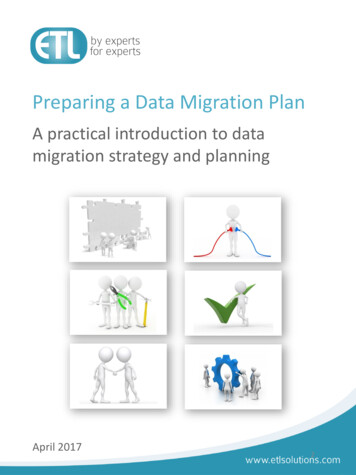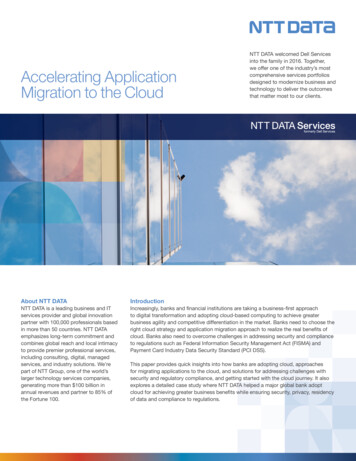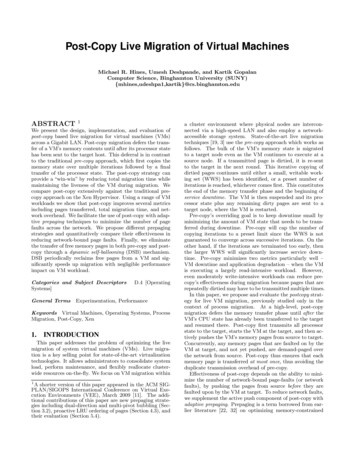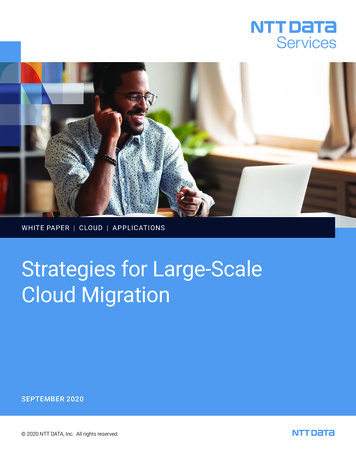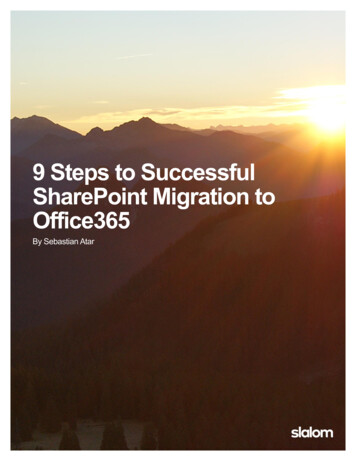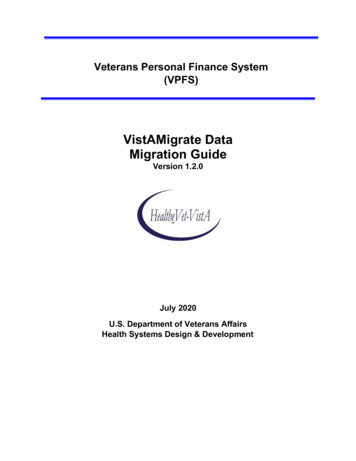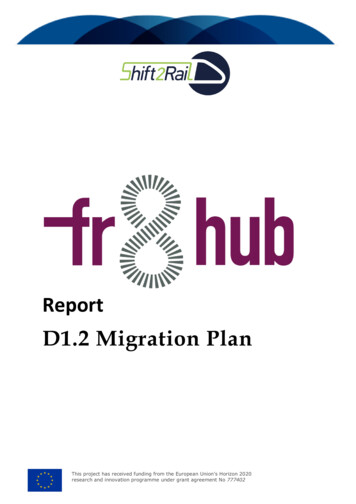
Transcription
ReportD1.2 Migration PlanThis project has received funding from the European Union’s Horizon 2020research and innovation programme under grant agreement No 777402
D1.2 Migration PlanContract No:H2020 – 777402Project Acronym:FR8HUBProject Title:Real-time information applications and energy efficientsolutions for rail freightFunding Scheme:Project funded from the European Union’s Horizon2020 research and innovation programmeInnovation programme5 - freightProject Start:1st of September 2017Project End:28th of February 2021Deliverable No.:D1.2 Migration PlanStatus/date of document:Final Report, 03/02/2021Project Coordinator:TrafikverketRöda Vägen 1SE - 781 89 BorlängeLeader of this Deliverable:ConTraffic GmbHHaeselerstraße 2014050 BerlinProject Website:http://projects.shift2rail.org/s2r ip5 n.aspx?p FR8HUBDissemination LevelPUPublicCOConfidential, restricted under conditions set out in Model Grant AgreementCIClassified, information as referred to in Commission Decision 2001/844/ECXPage 1 of 95
D1.2 Migration PlanVersion 02123/01/202125/01/2021DescriptionDraft introduction, research approach, structureRework of structure with new sections, WP1 workshop resultsconsideredWorkout for chapter 10 “getting started”Rework after TMT update 17.12.2020, Chapter 9 adopted, subchapters addedReworks after Review with TRV, chapters 8, Exec summary,introduction chapter 10Chapters 5.4.2, 6.4.2 reviewed, 10.4 added by B. Kordnejad (KTH)Chapters 9.3, 9.3.4 reviewed and addedFinal formatting, cross checks, reviewed by TMTPage 2 of 95
D1.2 Migration PlanTable of Content1Executive Summary . 82Background and Objectives . 103Investigation Approach . 124Operations and Competitiveness in Transport Business. 134.1SMART-RAIL Recognitions and Recommendations . 134.2SPECTRUM Project and the Relevance of LDHV Goods . 154.2.1General Market Trends . 154.2.2Transport Trends . 174.2.3The Importance of Containerised Cargo/Loading Units for Rail Freight Transport. . 184.3Freight Customer Needs – Findings of S2R CCA . 194.4Future Production Modes for a competitive Rail Freight System. 215Identification of Key Technologies – Description of identified Solutions . 245.1Digitization & Automation Rail Systems (TD 5.1) . 245.1.1Condition Based Maintenance . 245.1.2Automatic Coupling . 255.1.3Freight ATO / C-DAS . 275.2Digital Network Management (TD 5.2) . 285.2.1Improved Methods for Timetable Planning . 285.2.2Real-time Yard Management . 305.2.3Real-time Network Management . 315.2.4Intelligent Video Gate Terminals . 325.3Smart Freight Wagon Concepts (TD 5.3) . 335.3.1Running Gear . 335.3.2Core Market Wagon . 335.3.3Extended Market Wagon . 335.3.4Telematics and Electrification . 335.4New Freight Propulsion Concepts (TD 5.4) . 345.4.1Last Mile Propulsion Systems . 345.4.2Radio controlled distributed Power . 345.4.3Freight Loco of the Future . 355.4.4Hybridisation of Legacy Shunters . 366Expected Impact of Technologies and Solutions . 376.1Digitization & Automation Rail Systems (TD 5.1) . 376.1.1Condition Based Maintenance . 376.1.2Automatic Coupling / Digital Automatic Coupler (DAC) . 386.1.3Freight ATO / C-DAS . 386.2Digital Network Management (TD 5.2) . 396.2.1Improved Methods for Timetable Planning . 396.2.2Real-time Yard Management . 396.2.3Real-time Network Management . 406.2.4Intelligent Video Gate Terminals . 416.3Smart Freight Wagon Concepts (TD 5.3) . 426.3.1Running Gear . 426.3.2Core Market Wagon . 426.3.3Extended Market Wagon . 436.3.4Telematics and Electrification . 446.4New Freight Propulsion Concepts (TD 5.4) . 456.4.1Last Mile Propulsion Systems . 45Page 3 of 95
D1.2 Migration Plan6.4.2Long Trains up to 1500 m . 466.4.3Freight Loco of the Future . 466.4.4Hybridisation of Legacy Shunters . 476.5Summary of the Benefits for the different Stakeholder Groups . 487Assessment of expected Benefits and Dependencies of Key Technologies. 497.1KPI-Modelling in Shift2Rail Impact-Projects. 497.1.1Objectives and Reference Scenarios . 497.1.2Assumptions for the Simulation . 517.1.3Results for specific Cost of Transport (LCC approach) . 537.1.4Results for Capacity . 557.1.5Results for Punctuality . 557.2Sensitivity Analysis with Cost Model for Rail Freight Transport. 567.2.1Idea and Proceeding . 567.2.2Distance Efficiency an underestimated Parameter . 567.2.3Parameter Study for SWL Traffic and OTL . 587.2.4Parameter Study for Intermodal Traffic with Impact of P2P and CTL Mode . 607.2.5Assessment of Future Competitiveness of Rail Freight . 627.2.6First Conclusions. 648Migration as a complex process for rail freight . 658.1Rational of Migration . 658.2Innovation Portfolio and Logical Order . 668.3Transformation of the Production System . 688.4Stakeholders View on the Benefits of Innovations . 708.5An economical Investigation of Capital Need for Migration. 718.6Sector Organisation and Solidification . 748.7Conclusion and strategical Imperative for Migration . 769Timeline of Migration. 789.1Basic Aspects for a Shift2Rail and timely Order . 789.2Socio-economical Constraints of the Sector . 799.3Risk Consideration of Migration Paths . 809.3.1Infrastructure and Access Points to the Rail Freight System . 809.3.2Approval of Technologies, in particular Rolling Stock. 819.3.3Standardisation of the Digital Automatic Coupling . 829.3.4Basic Time Availability of Standards for supporting Technologies/interim Solutions . 8410Getting started – reasonable initial Packages for Market Uptake . 8610.1 The Coupling Package . 8710.2 The Electrification Package . 8810.3 Real Block Train with the Long-haul and Shunting Locomotive (Lh-S) and EMW. 8910.4 Intelligent Video Gates . 9110.5 City Terminals . 9411References . 95Page 4 of 95
D1.2 Migration PlanList of figuresFigure 1. V-model . 10Figure 2. Work break-down structure of WP1 . 11Figure 3. TD structure of IP5 . 12Figure 4. Specific costs of land-based transport . 13Figure 5. Capacity of the global container ship fleet in the years 2006 to 2018 . 19Figure 6. CCA investigation on freight customer needs . 20Figure 7. Operational mode 1 - Point-to-Point (P2P) . 21Figure 8. Operational mode 2 - Closed Train Loop (CTL) . 22Figure 9. Operational mode 3 - Open Train Loop (OTL) . 23Figure 10. Example of the timetable planning process Trafikverket . 28Figure 11. Overall objectives of Shift2Rail . 49Figure 12. Freight transport process and reference times . 51Figure 13. Improvements of transport time by operational mode . 53Figure 14. Improvements of LCC by operational mode . 54Figure 15: Distance efficiency . 56Figure 16: Sensitivity of transport costs . 57Figure 17: Study – Influencing specific cost of transport for SWL-Traffic . 58Figure 18: Study – Impact of OTL-Concept on cost of transport compared to SWL. 59Figure 19: Simulation of Unit Cost in P2P mode compared with Combined traffic CT today . 61Figure 20: Simulation of Unit Cost in CTL mode compared with Combined traffic CT today. 62Figure 21: Competitive matrix for transport systems for containers/swap bodies . 63Figure 22: Competitive matrix for transport systems for single wagon load transport . 64Figure 23. Rational of Migration . 65Figure 24. Application of migration rational to IP5 activities . 66Figure 25. Interdependencies of the 5 core innovations areas and the 10 supporting technologies . 67Figure 26. Transformation of UIC Production Modes to competitive FR8RAIL . 69Figure 27. Retrofit capital expenditure – wagons and locomotives . 72Figure 28. Stable book values for mobile assets rail freight . 73Figure 29. Wagon fleet composition until 2050. 73Figure 30. Locomotive fleet composition until to 2050 . 74Figure 31: Structure of net value added in the sector . 74Figure 32. Basic thought on migration of the rail freight system – the dilemma of transformation . 77Figure 33. Rough timeline for further development up to the revolutionary step of full automation . 78Figure 34. Barriers to implementation for the DAC migration . 83Figure 35. Barriers to implementation – Difficulty rating . 83Figure 36. Technology Pathway Electrification - WOBU - STI - CBM/ATO . 85Figure 37. Market uptake: Transformation of the rail freight system along a “process ofdisplacement” . 86Figure 38. Concept for integrated Long-haul/Shunting Locomotive . 90Figure 39. EMW based train concept . 90Figure 40: The main identified benefits of the IVG concept. . 92Figure 41: Urban logistic with Rail Hub . 94Page 5 of 95
D1.2 Migration PlanList of tablesTable 1: Comparison of turnover per tkm at DB Cargo and Green Cargo as evidence of lowcompetitiveness of rail freight services . 14Table 2. Coupler types defined in the FR8RAIL project with different levels of automation andfunctionality . 26Table 3. Tabular presentation of benefitting stakeholders by solution . 48Table 4. Reference parameters for average national and European freight transport . 50Table 5. Reference freight wagon types . 50Table 6. Different kind of LCC impact by TDs . 51Table 7. TDs with direct impact on LCC. 52Table 8. TDs with impact on freight capacity . 55Table 9. TDs with impact on punctuality. 55Table 10: Loading track lengths of the DUSS terminals in Germany . 81Page 6 of 95
D1.2 Migration ASECEDEUFFL4EFR8HUBFR8RAILFR8RAIL 2GAGoAIMIPIPRIVGLUMAAPNSOTLP2PS2R JUSCSMPSTITDtkmTMSTMTTORUUITPWPWPLYMAutomated Rail Cargo Consortium, S2R project consortiumAnnual Work PlanBundesministerium für Verkehr und digitale Infrastruktur, German FederalMinistry of Transport and Digital InfrastructureConsortium AgreementCondition based MaintenanceCross Cutting ActivitiesConnected Driver Advisory SystemCooperation toolClosed Train Loop (operational mode)Digital Automatic CouplerDriver Advisory SystemEuropean CommissionExecutive DirectorEuropean UnionFuture Freight Loco for Europe, S2R project consortiumS2R project consortiumS2R project consortiumS2R project consortiumGrant AgreementGrade of AutomationInfrastructure ManagerInnovation ProgrammeIntellectual Property RightsIntelligent Video GateLoading unitMulti-Annual Action PlanNetwork StatementOpen Train Loop (operational mode)Point to Point (operational mode)Shift2Rail Joint UndertakingSteering CommitteeStrategic Master PlanSafe Train Integrity (system)Technical Demonstratortonne-km, Tonne-KilometreTraffic Management SystemTechnical Management TeamTerminal OperatorRailway UndertakingInternational Association of Public Transport)Work PackageWork Package LeaderYard ManagerPage 7 of 95
D1.2 Migration Plan1 Executive SummaryThe present report “Migration Plan” is going to show ways how to introduce solutions and newtechnologies under market conditions by clearly describing benefits and availability of solutions forshippers, operators and customers. It also considers dependencies between technologies andsolutions in order to develop reasonable migration paths which also have to take into account thefinancial capacity (limited resources). It is therefore a compilation of relevant technology andinnovation paths for European rail freight. The focus lies on a joint perspective of users and solutionproviders describing benefits of key technologies carried out not only in FR8HUB but also in the otherprojects of IP5.The research concludes that the development and implementation of new technologies alone willnot be enough to attract additional transport to rail. It will be imperative to change the way servicesare provided. Contrary to what is often assumed by the sector representatives, the lowcompetitiveness of rail is not due to too high costs and thus too high offer prices. Rather, today'sservice offer does not meet the expectations of a transparent, flexible and easy-to-integratetransport task. Lack of accessibility to and reliability of the overall system result in poor servicequality of rail. The yardstick here is not the system itself, but modern road freight logistics, whichhave improved enormously in recent decades and today set the standards from the transportcustomer's point of view.Rail does not have to compete with road for quality reasons alone. Road also dominates thosetransport segments that are at all relevant for significant growth and additional market shares forrail, as studies in FR8RAIL have shown.In this respect, the challenge of the sector is not only to innovate the system technologically, to makeloads trackable, etc.; it is also to break with previous beliefs in order to establish new, market-drivenand highly utilised production concepts. Taking into account the economic and financial possibilitiesof the sector, the authors propose a two-part migration approach - consisting of an evolutionary pathwhere previous production concepts are improved through the deployment of new solutions. Thisessentially pays for single wagonload traffic or traffic that provides for a more or less continuoustrain configuration along a route. The second migration path has a revolutionary character, breakingwith previously mentioned compatibilities to the UIC system, providing for new wagon material infixed train configurations that can be fitted into a timetable traffic due to higher running speeds andan overall more dynamic running behaviour, thus enabling new production concepts. Both paths areinitially followed in parallel over a period of about 20 years, with the initial islands of innovation ofthe revolutionary approach being continuously expanded and gradually pushing back the currentsystem.This should not give the impression that the costs of service provision do not play a role. Theestablishment of new concepts and the introduction of new technologies naturally also serve tofurther reduce the specific transport costs in order to survive in competition in the long term withexpected increases in efficiency in road freight transport.Chapters 2 and 3 first give an overview of the background and objectives of work package 1 in theFR8HUB project and briefly describe the research approach.The fourth chapter reflects observations made by the Lighthouse project SMART-RAIL in terms ofcompetitiveness considering the specific costs of road and rail transport. These are complementedby recent EUROSTAT publications. Furthermore, research results from SPECTRUM on transporttrends and recent investigations of S2R cross-cutting activities on customer needs were reflected.Page 8 of 95
D1.2 Migration PlanThe comparison leads to the conclusion that the low competitiveness of rail freight today is not dueto the cost position, but due to other criteria.Chapters 5 and 6 present the various solutions and technologies that are developed within theframework of the various IP5 projects and describes the respective innovation potential and theobjective of a solution or technology. It is also to show possible benefits expected by the experts.Section 6 also describes the form in which the solutions pay into the three main KPIs of Shift2Rail(LCC, punctuality and capacity) and which stakeholders would benefit significantly from the marketlaunch.While in Chapter 6 the effects and benefits are considered essentially without compound effect,Chapter 7 deals with the first research results of the CCA project IMPACT-2, that with its modelsevaluates positive as well as negative effects of the solutions in interaction with each other.Chapters 8 to 10 are then devoted to migration considerations in more detail. In addition toimportant general information on the migration of new technologies with different degrees ofnovelty (Chapter 8) there is also a section in this chapter which highlights the financial aspects ofmigration, the presumably cautious willingness to make new investments with only a slight increasein productivity. The ninth chapter sets out a rough timeline as to when which technologies will beready for the market. The perspective of the transformation of the sector is discussed with scenarios.Chapter 10 presents reasonable initial steps to start the migration process with reasonable measuresfor market uptake.Page 9 of 95
D1.2 Migration Plan2 Background and ObjectivesGenerally, it is the aim of all measures in IP5 to make not only reasonable but also ambitiouscontributions to the S2R goals. Due to economic and logistical reasons, newly developed solutionscan’t be implemented at once. In some cases, technologies and/or solutions developed in IP5 dependon another. That means, the innovation measures must be put in a logical and chronological order toensure a successful market uptake. Therefore, innovation graphs/paths are projected in aninterdependence table from which the migration plan for European freight rail, market segments andstakeholders can be derived. The migration plan will have a great effect on the innovation capacityby proving that a better order of technology implementation will lead to fasters benefits for thecustomers.The migration plan is going to show ways how to introduce new technologies under marketconditions by clearly describing benefits and availability of solutions for shippers, operators andcustomers, taking dependencies between technologies and solutions, their evolutionary steps intoaccount. It is a compilation of relevant technology and innovation paths for European freight rail. Thefocus lies on a joint perspective of users and solution providers describing benefits of keytechnologies carried out not only in FR8HUB but also in the other projects of IP5.ConceptValidationDesign & nProposal for standardsSystemRequirementsTechnical RecommendationsVerificationDemonstratorsUse CasesWP1: migration planSystemDefinitionIntegrationFigur e 1. V-m ode lThe migration plan is also following the V-model approach but as a general guidance forintegration of different techniques, technologies and objectives in the whole of IP5 and has therebya larger scope than applicable in the diagram above.The work of WP1 is carried out in three phases1. Identification of key technologies that are carried out in the different TDs and connectionsbetween them (incl. results of SMART-RAIL)2. Creation of a logical timeline along the different functional levels of each keytechnology/solution3. Evaluation of benefits to shippers, customers and operators (incl. short-term wins)Page 10 of 95
D1.2 Migration PlanThe compilation of the three phases will lead to the overall migration plan and is expected to be aconsistent and realistic concept for the market introduction and European wide roll-out of thedifferent technologies and solutions developed in IP5.The work break-down structure was set as follows:FR8Hub WP1 – Migration Plan1.1 Identification of keytechnologies that arecarried out in thedifferent TDs andconnections betweenthem1.2 Creating a timelinealong the differentfunctional levels of eachkey technology/solution(Leader: DB)1.3 Evaluation of benefitsto shippers, customersand operators1.4 Migration plan as aresult of T1.1 to T1.3(Leader: CON)(Leader: TRV)(Leader: CON)D1.1 Mid-term reporton key technologies,further evolutionarysteps and theirinterrelations – thedeliverable will be afirst draft of themigration plantechnology/solutionproviders‘ perspectiveD1.2 Migration Plan Concept report for themarket introductionand European wideroll-out of relevanttechnologiesdeveloped in IP5market perspectiveFigur e 2. Wor k br eak -do wn s tr uc t ur e of WP1Page 11 of 95
D1.2 Migration Plan3 Investigation ApproachThe study design follows the TD structure in IP5 and illuminates the technologies and solutionsdeveloped therein. First, the results of all work packages of the current projects (FFL4E, ARCC,FR8RAIL and FR8HUB) were examined. In part, it was necessary to fa
Rework after TMT update 17.12.2020, Chapter 9 adopted, sub chapters added 0.5 18/01/2021 Reworks after Review with TRV, chapters 8, Exec summary, introduction chapter 10 0.6 22/01/2021 Chapters 5.4.2, 6.4.2 reviewed, 10.4 added by B. Kordnejad (KTH) 0.7 23/01/2021 Chapters 9.3, 9.3.4 reviewed and added


